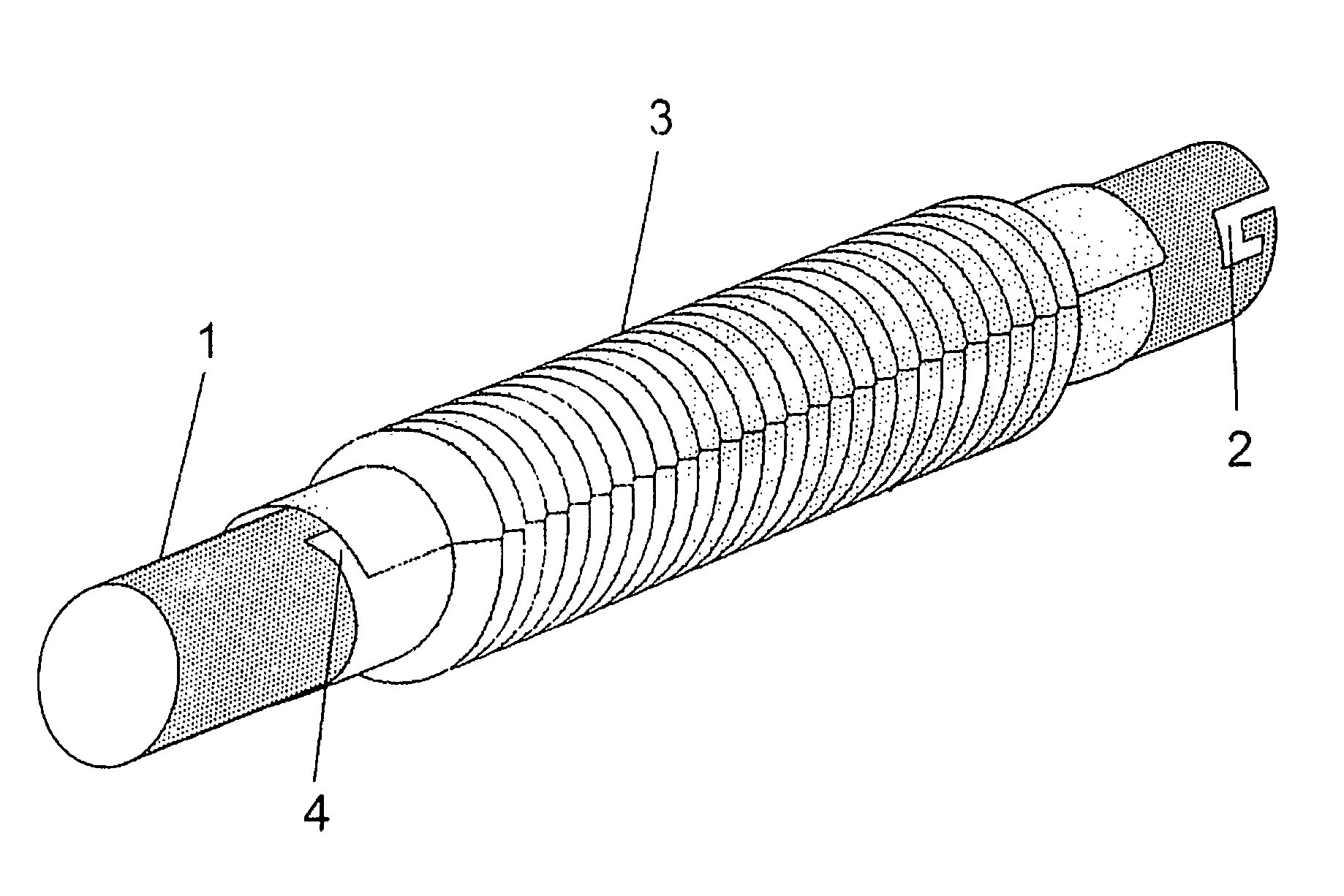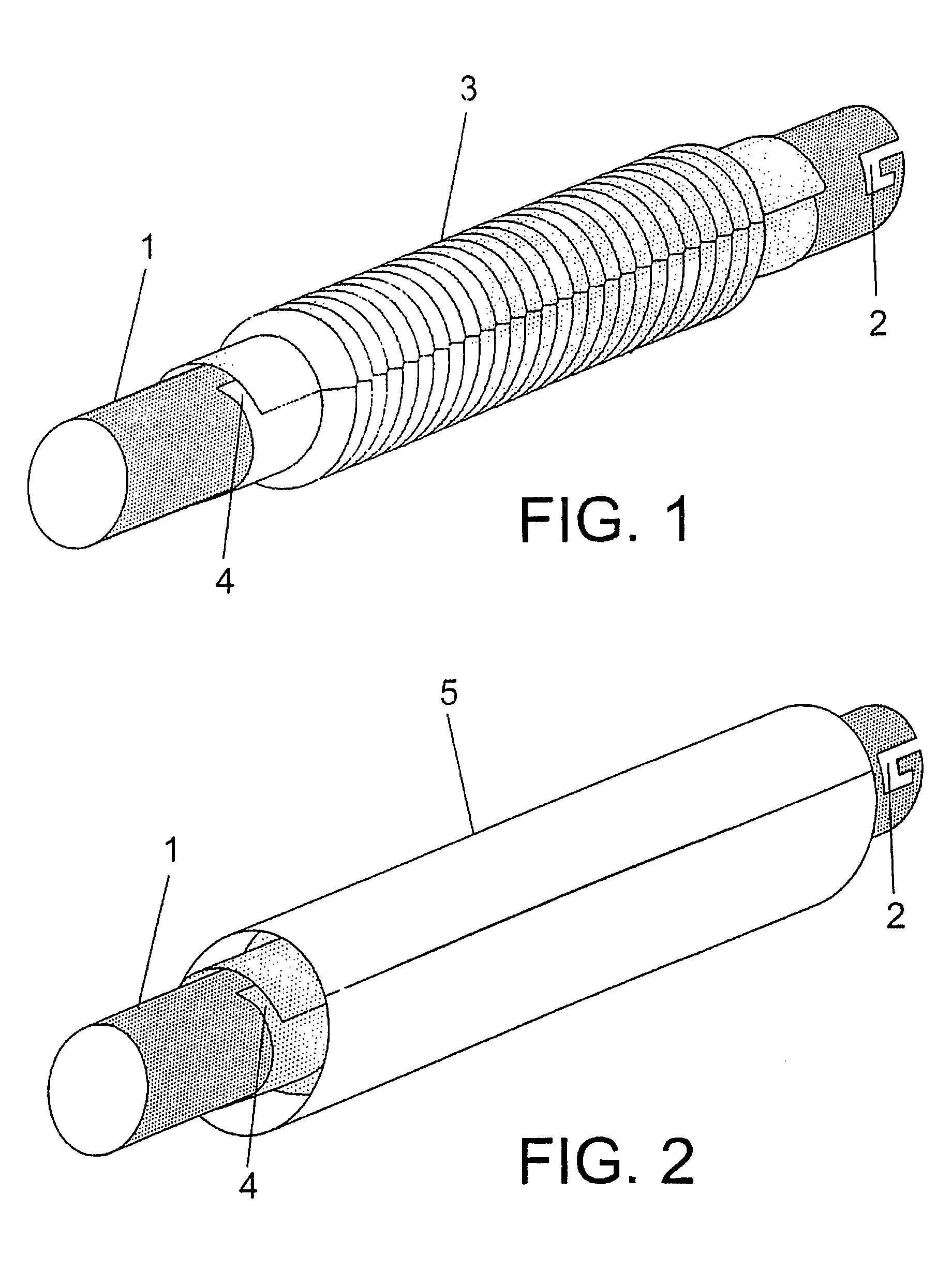Ready to use food product packaging film and production method therefor
- Summary
- Abstract
- Description
- Claims
- Application Information
AI Technical Summary
Benefits of technology
Problems solved by technology
Method used
Image
Examples
example 1
[0063]30 meters of collagen film COFFI® of 380 mm width were shirred on a plastic support tube of 50 mm inner diameter and 53 mm outer diameter. These were coated with a separation sheet made of polyethylene 0.04 mm thick, and on the latter were shirred another 30 meters of a latex / polyester elastic net with 16 circumferential spaces and a separation of 5 knots between coils of elastic material, as described above. The film and net assembly occupied 35 cm length with a film front not coated by the net of 5 cm.
[0064]A meat product was stuffed inside the shirred film coated with the described net, consisting of lean pork meat with a 20% brine injection cut in irregular pieces of 5 to 7 cm, for which a stuffing machine Handtmann VF 200 was used connected to work automatically with a clipping machine Poly Clip 3462. Pieces of 1,000 g weight were stuffed at a rate of 30 pieces per minute.
[0065]The same operation performed in an applicator COFFI® Garos 90 mm coupled to the same stuffing m...
example 2
[0068]25 meters of collagen film COFFI® of 380 mm width were shirred on a plastic support tube of 50 mm inner diameter and 53 mm outer diameter. These were coated with a separation sheet made of polyethylene 0.04 mm thick, and on the latter were shirred another 25 meters of a latex / polyester elastic net with 16 circumferential spaces and a separation of 5 knots between coils of elastic material, as described above. The film and net assembly occupied 30 cm length with a film front not coated by the net of 5 cm.
[0069]A meat product was stuffed inside the shirred film coated with the described net, consisting of lean pork meat with a 20% brine injection cut in irregular pieces of 5 to 7 cm, for which a stuffing machine Vemag robot HP 10 C was used connected to work automatically with a clipping machine Poly Clip DFC 8162. Pieces of 1,400 g weight were stuffed at a rate of 27 pieces per minute.
[0070]The same operation performed in an applicator COFFI® Garos 90 mm coupled to the same stu...
example 3
[0073]22 meters of collagen film COFFI® of 470 mm width were shirred on a plastic support tube of 67 mm inner diameter and 70 mm outer diameter. These were coated with a separation sheet made of polyethylene 0.04 mm thick and on the latter were shirred another 22 meters of a latex / polyester elastic net with 22 circumferential spaces and a separation of 5 knots between coils of elastic material, as described above. The film and net assembly occupied 27 cm length with a film front not coated by the net of 5 cm.
[0074]A meat product was stuffed inside the shirred film coated with the described net, consisting of lean pork meat with a 20% brine injection cut in irregular pieces of 5 to 7 cm, for which a stuffing machine Vemag robot HP 10 C was used connected to work automatically with a clipping machine Poly Clip DFC 8162. Pieces of 2,600 g weight were stuffed at a rate of 25 pieces per minute.
[0075]The same operation performed in an applicator COFFI® Garos 90 mm coupled to the same stuf...
PUM
| Property | Measurement | Unit |
|---|---|---|
| Pressure | aaaaa | aaaaa |
| Length | aaaaa | aaaaa |
| Shape | aaaaa | aaaaa |
Abstract
Description
Claims
Application Information
 Login to View More
Login to View More - R&D
- Intellectual Property
- Life Sciences
- Materials
- Tech Scout
- Unparalleled Data Quality
- Higher Quality Content
- 60% Fewer Hallucinations
Browse by: Latest US Patents, China's latest patents, Technical Efficacy Thesaurus, Application Domain, Technology Topic, Popular Technical Reports.
© 2025 PatSnap. All rights reserved.Legal|Privacy policy|Modern Slavery Act Transparency Statement|Sitemap|About US| Contact US: help@patsnap.com



